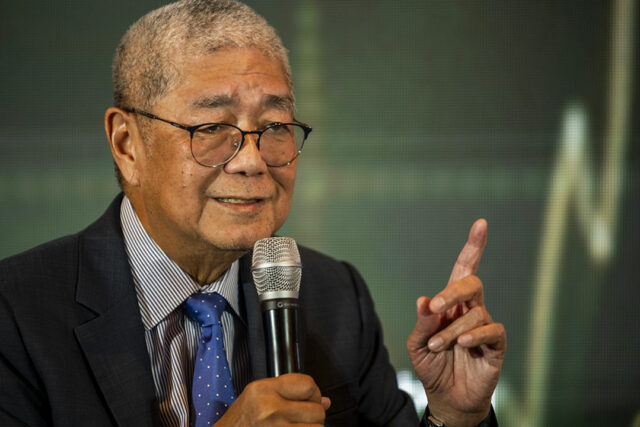By Sheldeen Joy Talavera and Ashley Erika O. Jose, Reporters
THE LUZON and Visayas grids were placed on red and yellow alerts on Tuesday after several power plants went on forced outage.
The Institute for Climate and Sustainable Cities (ICSC) on Tuesday said the Luzon power grid will likely experience a shortfall in power supply until May as the majority of hydroelectric power plants are expected to run on derated capacity.
“We are [seeing] the threat of power supply deficiency especially since power supply conditions are exacerbated which is expected to impact the hydropower capacity,” Jephraim C. Manansala, chief data scientist at the Institute for Climate and Sustainable Cities (ICSC), said at a briefing on Tuesday.
The Luzon power grid is projected to be the most affected by the looming power supply deficiency as the majority of hydroelectric power plants supplying the grid will be running on low capacity, the think tank said.
“The threat of power supply deficiency during the dry season is looming, where the major concern is the higher-than-usual temperatures associated with the El Niño weather phenomenon, which are expected to impact hydropower capacity across the country,” the Manila-based climate and energy policy group said.
ICSC said that around 1,435 megawatts (MW) or 70% of the 2,050-MW hydroelectric capacity will be unavailable in the Luzon grid during the dry season.
Power demand typically surges during the hot summer months. Mr. Manansala said Luzon is expected to experience the tightest power supply between May 16 and May 30, adding that yellow alerts are expected from April 29 to May 26.
Peak demand is expected in May, reaching 13,917 MW in Luzon, 2,834 MW in Visayas, and 2,584 MW in Mindanao, ICSC said.
“El Niño reduces the available capacity from hydroelectric power plants. All baseload power plants need to be compliant with the grid operating and maintenance program and any unplanned outages may deplete operating reserves levels,” Mr. Manansala said.
The El Niño weather phenomenon has started weakening but will still persist until May, the state weather bureau said, adding that its effects may last until August.
ICSC said there will be minimal impact on the Visayas grid as the region has limited hydroelectric capacity, while the Mindanao grid is expected to maintain normal reserves during the period.
The sufficient power reserves in Visayas and Mindanao is also due to the high-voltage direct current (HVDC) imports from Mindanao with the expanded operations of Cebu-Negros-Panay transmission and the Mindanao-Visayas Interconnection Project (MVIP). The MVIP allows Mindanao to export up to 450 MW to Visayas allowing the region to have power supply security.
The country’s recurring power supply problems stem from the centralized and baseload-reliant plants, Pedro H. Maniego, Jr., senior policy advisor of ICSC, said.
Baseload power plants, like coal-fired plants, are those that can continuously generate power to meet the power demand.
Alberto R. Dalusung III, energy transition advisor at the ICSC, said the government must focus on the timely delivery of the committed power plants and the improvement of the grid to accommodate additional power capacity.
“There has to be expansion of the transmission system. So, we can definitely absorb more renewables and more [technologies] like biomass, geothermal, and this imposes less requirements on the grid,” Mr. Dalusung said.
YELLOW, RED ALERTS
Meanwhile, the National Grid Corp. of the Philippines (NGCP) said that a red alert was placed over Luzon between 2-4 p.m. and 6-9 p.m. on Tuesday.
A yellow alert was placed over Luzon from 1-2 p.m.; 4-6 p.m.; and 9-11 p.m.
Yellow alerts are issued when the supply available to the grid falls below a designated safety threshold. If the supply-demand balance deteriorates further, a red alert is declared.
The NGCP said that the peak demand was at 13,024 MW, which nearly outpaced the available capacity of 13,537 MW.
“Nineteen power plants are on forced outage, while three others are running on derated capacities, for a total of 2,117.3 MW unavailable to the grid,” the grid operator said.
Based on the data from the NGCP, power plants that went on forced outages in Luzon include Pagbilao units 1 and 2, Masinloc 1, Sta. Rita 40, Southwest Luzon Power Generation Corp. 2, Bakun 1 and 2, Ambuklao 1 and 2, Binga 1 and 4, Bineng, BT2020, the generating unit of the National Irrigation Administration, VS Gripal Power Corp., Maris 1 and 2, NMH, and Irisan.
As of 5:09 p.m., the NGCP extended the red alert status in Luzon to 11 p.m. due to the outage of two additional plants: Kalayaan 1 and 2 at 180 MW each.
Sought for comment, First Gen Corp. Vice-President for Corporate Communications Ramon A. Carandang said that the Sta. Rita plant is targeted to sync with the grid on Wednesday morning.
“The protection system activated Sunday due to a minor issue, so they had to repair it. They’re supposed to be online, they’re supposed to be functioning again, Sta. Rita, by (Tuesday night),” Mr. Carandang said on the sidelines of an event.
A yellow alert was also declared over the Visayas grid between 2-4 p.m. and 6-9 p.m. During the period, the available capacity was at 2,742 MW while the peak demand was 2,440 MW.
The NGCP said that 12 power plants are on forced outage, while five are at limited capacity, bringing the unavailable capacity to 676.5 MW.
A red alert in Visayas was later raised between 5-9 p.m. due to an outage of an additional power plant, KEPC SPC Power Corp. 1 at 103 MW.
Energy Regulatory Commission (ERC) Chairperson Monalisa C. Dimalanta said that they will investigate the power outages that took place.
“There are those plants that are on planned outages that have extended their period of repair. So those are the complications that we really cannot anticipate,” Ms. Dimalanta told BusinessWorld on the sidelines of an event.
The NGCP said as of 4:16 p.m. that MLD was implemented in parts of Baguio City, Benguet, Ilocos Sur, Nueva Ecija, and Aurora, to protect the integrity of the power system.
MORE POWER PROJECTS
In a separate statement, the NGCP has called for more power generation projects to avoid outages in the Visayas amid the full energization of the Cebu-Negros-Panay 230-kilovolt Backbone Project Stage 3 (CNP3).
“The project’s completion was touted by some parties as the primary solution to the recent spate of power outages in Negros and Panay. But CNP3 is not the sole or primary solution to the woes of Panay consumers,” the grid operator said.
The NGCP said that the development of sufficient power generation supported by reliable transmission is the key “for optimized energy development.”
“While the line will help improve the delivery of power, more baseload plants in Negros and more in-island generation in Panay are needed to prevent the occurrence of power outages,” the NGCP said.












